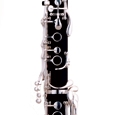To be able to improve as a clarinetist it takes a good instrument in good condition. However, it is not enough to simply buy the best instrument; it takes maintenance to keep a clarinet in good working order.
Bore oil kits help maintain the integrity of the wood. It is best to oil the instrument before playing, when the bore is dry. Frequency of oiling to prevent cracking depends on climate. A dry climate requires more frequent oiling, and in a humid climate it may be necessary only rarely, if at all. Avoid sudden extreme temperature changes; moving from heat to cold increases the risk of cracking the wood. If the inside of the upper joint feels somewhat grainy, it is a good time to oil the clarinet.
Use a soft cloth brush to oil the bore, carefully inserting it into the inside of each joint. Apply a light coat of oil, being careful not to get any excess on the pads. Allow the oil to penetrate the wood for 10-15 minutes. If the bore still feels dry, apply a second light coat. Using a clean swab, remove any remaining oil. Cigarette paper without glue may be used to blot under the pads.
Swabbing moisture out after each playing session is extremely important; leaving moisture in the instrument weathers the wood over time and leaves residue in the bore. For the best tone and response, the surface of the bore should be smooth.
Keys should be oiled periodically to remain in good working order. The nozzle on many oil bottles often lets too much oil out and may leak onto the pads, ruining them. Remove the nozzle of the bottle and dip a toothpick into the oil. Oil should be applied to the connecting rods where key action is visible. Check for oil that may have seeped into the tone holes; any excess should be carefully blotted away.
Check for key wear by trying to wiggle connecting rods; they will move back and forth easily when a key is worn. A qualified repairman can easily fix this.
If pads are brown, they no longer provide a good seal, and if the fish skin covering them is broken, there will be a buzzing sound on the affected key. Old pads are frequently replaced with new ones that are thicker, which may muffle the sound of the note; the tone holes require adequate venting to play a clear, even sound.
Keys should be adjusted to the same tension by a repairman. Watch for small movement in the throat tone A key before it connects with the G# key. If the adjustment screw on the A key is tightened so much that it removes this movement, the G# key may leak and cause occasional squeaking.
If there is looseness in the corks and tendons and the joint can be wiggled back and forth, it needs to be recorked. In an emergency, thread may be tightly wrapped on the tendon. Apply cork grease and the damaged or loose joint is temporarily tightened.
Mouthpiece care is extremely important. Investigate the mouthpiece facing, especially on the top and side rails, for chips and scratches; even small nicks significantly change the way a mouthpiece plays. After playing, use a soft cloth, similar to what might be used to dry the inside of a glass, to dry the mouthpiece. If residue is allowed to build up, it affects mouthpiece performance; rinse a mouthpiece with cool to lukewarm water as needed.





